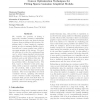Free Online Productivity Tools
i2Speak
i2Symbol
i2OCR
iTex2Img
iWeb2Print
iWeb2Shot
i2Type
iPdf2Split
iPdf2Merge
i2Bopomofo
i2Arabic
i2Style
i2Image
i2PDF
iLatex2Rtf
Sci2ools
116
click to vote
ICML
2006
IEEE
2006
IEEE
Convex optimization techniques for fitting sparse Gaussian graphical models
We consider the problem of fitting a large-scale covariance matrix to multivariate Gaussian data in such a way that the inverse is sparse, thus providing model selection. Beginning with a dense empirical covariance matrix, we solve a maximum likelihood problem with an l1-norm penalty term added to encourage sparsity in the inverse. For models with tens of nodes, the resulting problem can be solved using standard interior-point algorithms for convex optimization, but these methods scale poorly with problem size. We present two new algorithms aimed at solving problems with a thousand nodes. The first, based on Nesterov's first-order algorithm, yields a rigorous complexity estimate for the problem, with a much better dependence on problem size than interior-point methods. Our second algorithm uses block coordinate descent, updating row/columns of the covariance matrix sequentially. Experiments with genomic data show that our method is able to uncover biologically interpretable conne...
Empirical Covariance Matrix | ICML 2006 | Large-scale Covariance Matrix | Machine Learning | Maximum Likelihood Problem |
Related Content
| Added | 17 Nov 2009 |
| Updated | 17 Nov 2009 |
| Type | Conference |
| Year | 2006 |
| Where | ICML |
| Authors | Onureena Banerjee, Laurent El Ghaoui, Alexandre d'Aspremont, Georges Natsoulis |
Comments (0)

